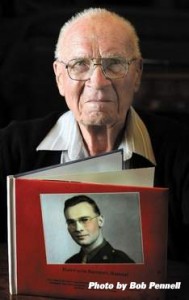By Paul Fattig
Article originally appeared in the Mail Tribune
 When Army medic Harold Hayes climbed aboard the Army transport plane on Nov. 7, 1943, in Sicily, he anticipated landing in nearby Italy some two hours later.
When Army medic Harold Hayes climbed aboard the Army transport plane on Nov. 7, 1943, in Sicily, he anticipated landing in nearby Italy some two hours later.
Instead, the four-member crew and its 26 passengers of Army nurses and medics would become lost in a massive storm encircling the heel of Italy, be forced to land near a remote lake in Nazi-held Albania, then dodge enemy troops for more than two harrowing months before being rescued.
“It sure wasn’t something any of us expected,” said Hayes, 91, of Medford. “We thought we would be in Italy for a very short time, then return.”
Hayes is the last surviving member of the 30-member group whose story is told in “The Secret Rescue: An Untold Story of American Nurses and Medics Behind Nazi Lines.”
The book is a page turner that tells of their narrow escape with the help of American and British intelligence officers.
Hailing from Iowa, draftee Hayes, then 21, was assigned to an Army medical evacuation unit based in Sicily late in 1943. The mission of the group, which included 13 female nurses, was to fly to Italy in a C-53 transport plane to evacuate sick and wounded from Bari.
“It was a version of the Douglas DC-3, which was one of the most used airplanes until the 737 came along,” said Hayes, a retired airplane designer.
“For three days, we had gone to the airfield only to be told all flights were canceled because of the heavy rain,” Hayes continued. “On that day it was clear.
“But before we got to the coast — maybe six miles or so — I saw a small cumulus cloud,” he added. “The farther we went the more clouds we ran into.”
When the pilot took the aircraft above the clouds, the wings began icing up. But when they found a break in the weather, a German fighter plane chased the defenseless plane back into the clouds.
After playing cat and mouse with the enemy fighters, the crew became lost. Unbeknownst to them, they had crossed the Adriatic Sea into enemy territory.
With the plane low on fuel, the pilot decided to land on the edge of a small lake.
“The pilot made a skillful landing,” Hayes recalled. “But it came to an abrupt stop when the wheels bogged down in the mud. It turned up on its nose and fell back again.”
The crew chief, who was not wearing a seat belt, was the only one seriously injured but would survive.
Not only were they in enemy territory but the region was also being torn apart by a civil war led by a communist faction.
“We were caught in the middle of all of that,” he said.
They were met by a small group of partisans who offered their help. A man who could speak rudimentary English told them there were German troops about four hours away.
The partisan leader took them to a village two hours farther away from the enemy troops.
The next day the crew, including Hayes, returned to the plane to salvage what gear they could and burned the plane.
Meanwhile, his parents back in Indianola, Iowa received a Nov. 26 telegram from the War Department that no parent ever wants to read during a time of war:
“REGRET TO INFORM YOU REPORT RECEIVED STATES YOUR SON TECHNICIAN THIRD GRADE HAROLD L. HAYES MISSING IN THE NORTH AFRICAN AREA SINCE 8 NOV,” it stated, noting the family would be contacted when more information was available.
Because enemy troops occupied the larger towns and periodically ventured into remote villages, the group stayed away from well-traveled routes, traveling largely by night.
Several times the Nazi troops would arrive in a village shortly after Hayes and his group had left, he said.
“Food was in very short supply at the villages,” he said. “We frequently went a day without food and even then the food we got was a little cube of corn bread.
“It was the gosh-awfulest corn bread you could imagine,” he added. “All it was some course ground corn meal mixed up in a slurry of water and baked with no seasoning.”
But they were thankful to get anything to eat. His Christmas dinner that year was a watery soup of boiled sheep intestines.
An Army intelligence estimate indicated that during their journey they had covered at least 342 miles, Hayes said, although adding steepness of the terrain added many more miles.
“Some days we walked 24 hours without stopping,” he said. “We were on the move for almost 40 (continuous) hours with no sleep at the end.”
They would make their way to the coast, where they met up with a British boat at midnight — 63 days after they had landed in Albania.
“One person told me it was one of those experiences you wouldn’t take a million dollars for but you wouldn’t do it again for another million,” Hayes said, adding that he concurred.
He would later go to officer’s candidate school and complete his hitch in the Army as a second lieutenant.
Following the war, Hayes attended what is now Iowa State University on the GI Bill, earning a bachelor’s degree in aeronautical engineering. He and Betty, his wife of nearly 69 years, have two grown daughters.
Reach reporter Paul Fattig at pfattig@mailtribune.com.